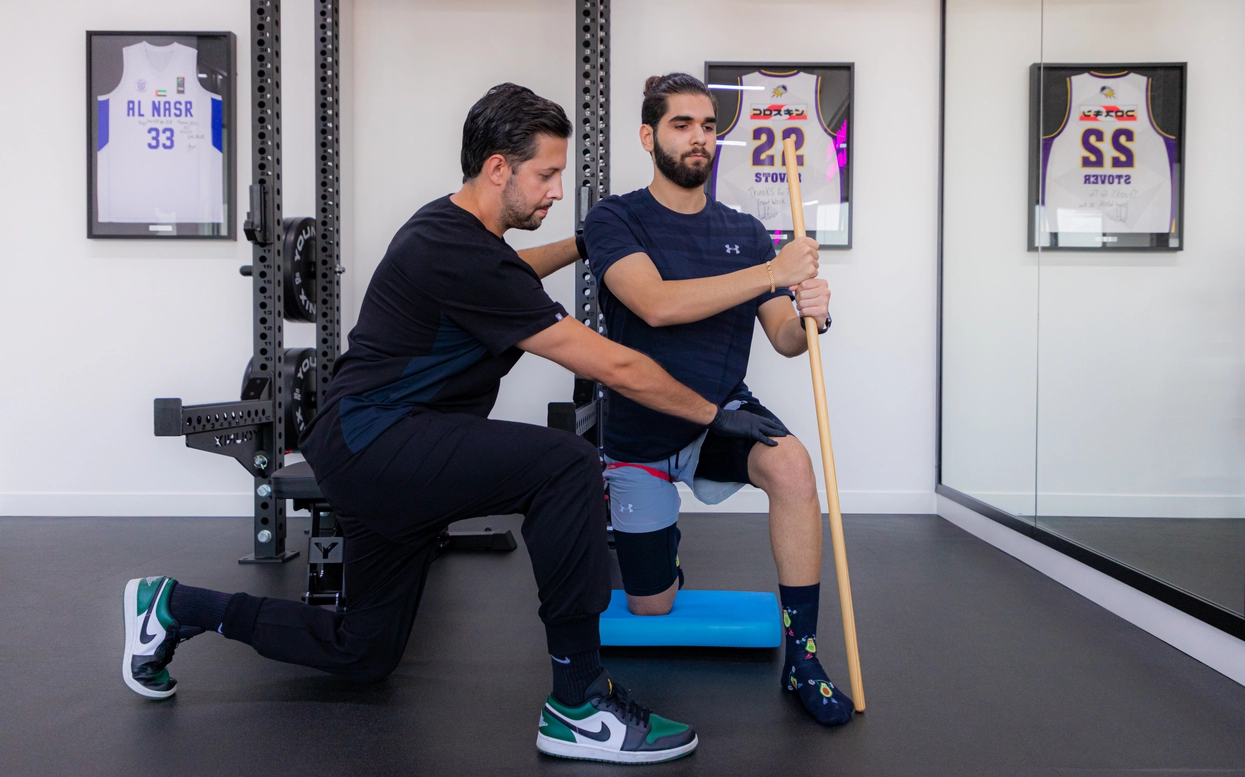Get Care
Sports Physiotherapy Dubai
Get back
To sport sooner with the help of a physiotherapist
At THE LAB, we offer tailored sports injury rehabilitation programs for athletes who have suffered a traumatic or chronic injury. Depending on the nature of the injury, our expert Physiotherapists will devise a program that will get you on the right road to recovery to ultimately get you back to what you love doing best! We work with all athletic abilities from School Leagues to Pro Athletes.
Sports injuries can occur due to overtraining, lack of conditioning, and improper form or technique. Failing to warm-up increases the risk of sports injuries.

Get help
From physiotherapists who know your sport
Physiotherapy stimulates the body’s natural healing process to heal faster, come back stronger, and prevent re-injury. Get help from the physiotherapists trusted by thousands of active individuals including professional athletes, Olympic hopefuls, and varsity athletes.
Most common sports injuries
Torn ACL
The anterior cruciate ligament (ACL) helps hold the knee joint together and provides stability. A torn ACL is a sports injury that may occur when landing the wrong way, changing direction or stopping quickly, or from a direct blow to the knee.
Torn MCL
The medial collateral ligament (MCL) connects the upper leg bone (femur) to the larger bone of the lower leg (tibia). It is located on the inner side of the knee. The MCL is typically injured when the knee joint is pushed sideways when making a wrong move or by receiving a direct blow to the knee. A torn MCL results in pain, swelling, and instability of the joint.
Shin Splints
Shin splint symptoms are throbbing, aching, or stabbing pain on the insides of the lower leg. Shin splints are a repetitive use injury that may occur in runners or those who are beginning to exercise. Pain occurs when muscles and tendons around the tibia (the larger of the two lower leg bones) become inflamed.
Stress Fracture
A stress fracture is an overuse injury that occurs when muscles are no longer able to absorb the impact from physical activity, and a bone absorbs the pressure, resulting in a break. Stress fractures can occur when increasing activity, especially too quickly. The majority of stress fractures occur in the lower legs and feet.
Plantar Fasciitis
The plantar fascia is a ligament that connects the heel to the front of the foot, supporting the arch. Plantar fasciitis is inflammation of this ligament. It causes heel pain often felt the first thing in the morning after getting out of bed or after being active. Stress and strain on the feet increase the risk of plantar fasciitis. Obesity, tight calf muscles, repetitive use, high arches, and new athletic activities are all risk factors for this condition.
Runner’s Knee
Runner’s knee is another repetitive-motion injury. It’s common to runners and anyone who does a lot of walking, biking, or general knee bending. It can also be caused by knee trauma or a hard bump to the knee. Symptoms include pain behind your kneecap, especially when you bend your knee. The area may be swollen, or you may feel a grinding sensation when your knee bends. These injuries can be both acute or chronic.
Tennis Elbow
Tennis elbow is a painful condition caused by overusing your elbow. Tennis players and golfers are likely to get it. It causes pain on the outside of your elbow. The pain is caused by inflammation in the tendons. Other symptoms may include weakness, especially as you try to grip objects. These injuries can be chronic.
Sprain
A sprain is one of the most common sports injuries. A sprain is a stretch or tear of a ligament near a joint, such as a knee, ankle, or wrist. Sprains are most often caused by falling or by a twisting motion. They can be mild or severe, depending on whether the ligament is stretched or torn. Symptoms are pain, swelling (sometimes severe), and bruising. You may also not be able to apply weight to the joint without pain.
Sports Injury Prevention
Physical activity is an important part of maintaining overall health. However, certain precautions should be taken to minimize the risk of sports injuries like using the correct equipment, maintaining equipment, and using the recommended protective gear. Resting between workouts gives the body time to rest and repair. Starting activity slowly and gradually increases strength, flexibility, and endurance gives muscles, bones, and other tissues the opportunity to adapt to more difficult workouts, minimizing the risk of injury. Finally, listening to the body and backing off at the first signs of pain, discomfort, stress, or overheating will help reduce the risk of sports injuries..
Come Back Stronger
To sport in the least amount of time
Our main aim is to get you back to sport as soon as possible. This requires a thorough assessment and a precise diagnosis. We closely monitor your progress, focusing on building strength and stability.
During your healing process, we focus less on making you pain free, and more on gaining function and mobility. Getting rid of pain doesn’t mean the underlying problem has been fixed. We’ll work with you to address the root cause of the injury.
We think of “rest” is a relative concept. It may simply mean reducing your training volume. It may surprise you that, depending on your injury, your recovery plan may include training more often (with less intensity).
Sports Physio Near You In Dubai
We take the time to understand your concerns, talk in-depth about what’s causing your pain